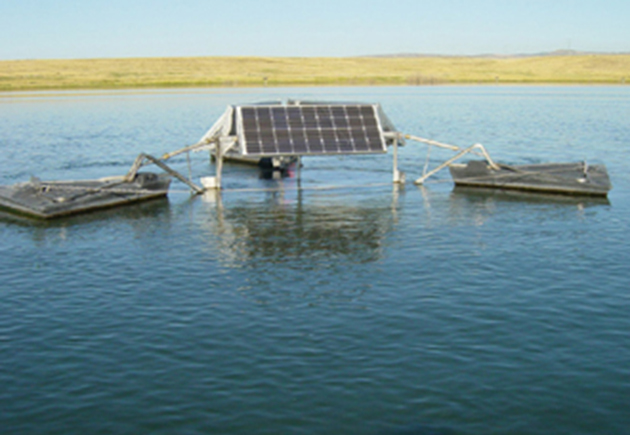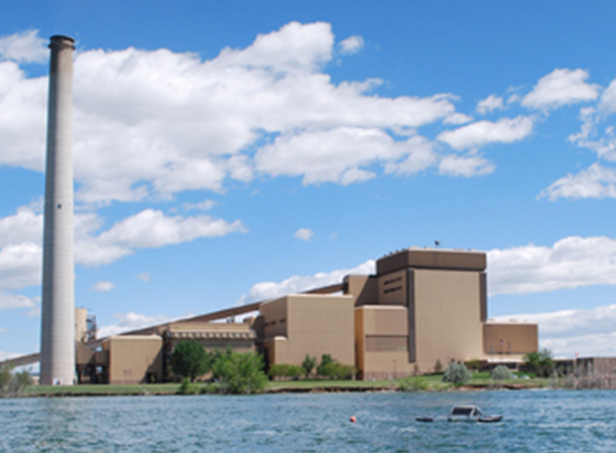Platte River Power Authority Restores Cooling Reservoir, Reducing Maintenance Costs And Improving Wildlife Habitat
Top-performing coal-fired power plant finds that SolarBee® solar-powered mixers combat blue-green algae in 500-acre reservoir without the need for chemicals or mechanical aeration.
Platte River Power Authority, which generates and delivers electricity to Fort Collins, CO, and surrounding communities, puts a premium on cost-efficient energy and environmental responsibility. As a result, the not-for-profit utility’s coal-fired power plant, Unit 1 at the Rawhide Energy Station, is one of the 10 best-utilized plants in the United States according to Electric Light & Power magazine. The plant operated at 93.9 percent of capacity in 2011 compared to an average 62 percent for all 520 U.S. coal-fired plants. One example of Platte River’s stewardship is a project at the Rawhide Station to improve water quality in the cooling reservoir and reduce associated operating costs. Working with Medora Corporation, Platte River officials found that solar-powered SolarBee mixers helped restore the reservoir’s water quality, replacing other less-than-successful attempts such as high-powered aeration and copper sulfate.
Although Platte River generates electricity from many sources — including natural gas and wind — its flagship site is the coal-fired Rawhide Energy Station Unit 1, with a 278 MW capacity, or about 30 percent of the utility’s total energy resources. Instead of using cooling towers, the plant relies on a closed-loop cooling cycle and stores water in the 500-acre Hamilton Reservoir. The reservoir’s water source is secondary-treated wastewater from Fort Collins, whose relatively high-temperature (10°C even during winter) and high-nutrient water had created an ideal environment for pond scum, or blue-green algae. Pea-soup pond scum not only looks and smells bad, but also increases maintenance and operating costs.

Platte River officials returned Hamilton Reservoir to its healthy state by installing 13 SolarBee SB10000v12 circulators throughout the reservoir.
Improving water quality was important not just for plant operations but also for the environment. About 30 bison, owned and managed by the utility, roam the site’s 4,560 acres, and thousands of native and migratory birds fly through. The National Audubon Society’s Christmas Bird Count at Rawhide centers on Hamilton Reservoir. The man-made reservoir remains relatively warm and ice-free during the winter because water returned to the reservoir from the plant retains the waste heat from the electricity generation process.
“The lake is a unique ecosystem,” said Gale McGaha Miller, plant chemistry supervisor, Platte River. “Anything we do for this water we want to make sure it’s not harmful to wildlife. The wastewater we receive from Fort Collins is suitable for discharge into riverways, but the reservoir is a closed system and even if the best water stays in one spot, it’s prone to algae growth. Besides algae, we were also concerned about declining dissolved oxygen levels in the lake.”
Yet ridding the reservoir of pond scum had been a stubborn problem. The utility tried a diffused aeration system with air provided by the plant’s 250 horsepower air compressors, copper sulfate treatments and even stocking the lake with fish, but all of these methods proved ineffective, and pH values remained at 9.
Horizontal Mixing: Like Throwing A Life Jacket To “Good” Green Algae
Recent research has shown that there is a simple, chemical-free, low-maintenance solution to controlling blue-green algae blooms. The answer is to create enough horizontal and vertical water movement to sufficiently disrupt large-celled blue-green algae and instead allow “good” small-celled algae to predominate. SolarBee mixers create a near-laminar flow, allowing the mixer to cover a large area with little energy. The mixing action restores the food chain and returns the reservoir to a healthy state.
Platte River officials returned Hamilton Reservoir to its healthy state by installing 13 SolarBee SB10000v12 mixers throughout the reservoir over a period of time. The mixers are equipped with hoses and float arms specially designed to withstand the high winds and waves that are common to the reservoir, which is a maximum 70 feet deep (average depth is 30 feet).
The mixers draw water in through the flow intake — set at the epilimnion at Hamilton Reservoir (top 5 to 10 feet, where water is warmest) — from all directions, pushing it upward and then sending it out across the surface in a thin layer.
Because of the constant horizontal and vertical movement, good green algae and diatoms are pulled up from below, lifted to the top and sent out across the surface again, where they receive sunlight and are available to zooplankton. It is this strong horizontal circulation that keeps green algae viable because the algae remain suspended where they can receive sunlight.
“The goal of a horizontal mixer is not to add oxygen to a pond,” said Joel Bleth, president, Medora Corporation. “That’s the work of green algae. The purpose of a horizontal mixer is to help the good algae survive. When the good algae survive, the levels of algae, zooplankton, fish, dissolved oxygen, and pH will stay in balance.” The blue-green algae never take over and the water returns to a natural green-tinted color — a “clear” indication that the reservoir is healthy.
“We finally have a solution to the problem,” said Rocky Knutson, Rawhide plant manager. “I’ve been at the plant 31 years, and we have tried our best to keep our chemical feed requirements low. We didn’t like using copper sulfate; research showed that BGA can quickly adapt to copper sulfate and build resistance, requiring higher and higher dosages. Although we don’t have specific cost-saving numbers, we see all kinds of evidence of improvement. We have a continuous condenser tube-cleaning system and no longer have bio-fouling concerns. The last time our condenser tubes were inspected, they looked brand new; many power plants have re-tubed their condensers due to excessive tube failures caused by bio-fouling.”

One of the nation’s top-performing coal-fired power plants, Rawhide Energy Station combats blue-green algae in the cooling reservoir without the need for chemicals or mechanical aeration.
In addition, Secchi water depths have improved to an average of over 8 feet, dissolved oxygen levels are up, and stratification is minimal.
“At one point, we were even considering lowering the entire reservoir level and re-filling with a more expensive and cleaner water supply” said McGaha Miller. “The SolarBee mixers have solved our reservoir’s problem operationally, aesthetically, and environmentally.”
About Medora Corporation
GridBee® and SolarBee® are brands of Medora Corporation (Dickinson, ND), whose award-winning circulation technology helps solve difficult water-quality problems. The patented technology can prevent and control blue-green algae in lakes and raw water reservoirs; provide energy savings, process improvement, and odor control in wastewater; and completely mix potable water tanks, eliminating stratification. Solar-powered and electric solutions are available. For more information, call 866-437-8076 or visit www.medoraco.com
